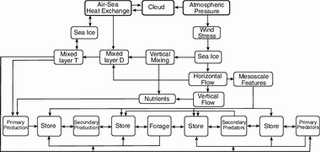
The complex pathways that weave together the biotic and abiotic components of the Bering Sea ecosystem are not all known, nor are all the interactions among the various components well understood. Yet, identifying and understanding mechanisms that transfer climate change in the atmosphere and ocean to biota is essential if we are to comprehend ecosystem dynamics (Francis et al., 1998). Fluctuations in the physical environment can impact the ecosystem through both changes in the nutrient-phytoplankton-zooplankton sequence (i.e., bottom up control), and/or by altering habitat or some other condition that results in changes in abundance and/or spatial composition of higher trophic level animals (i.e., top down control). Temperature, turbulence and transport are mechanisms through which the physics influences the biology. These, in turn, respond to wind and, for high latitude seas, sea ice. All of these phenomena are included in a conceptual model (Fig. 30.2) that provides a schematic of the pathways in which changes in the physical environment impact biota. While the sequence is generally thought of as unidirectional starting with changes in the atmospheric climate driving those in the ocean and on to biota, changes in oceanic environment (e.g., heat fluxes) can alter atmospheric features (a feedback loop). In this conceptual model, the direct influence of the physical environment is a function of trophic level; the arrows between levels represent both biological interactions and the communication of physical influences.
Figure 30.2: Pathways whereby changes in physical environment influence the biological processes (after Schumacher et al., 2003). Sea ice appears twice because it represents pathways for different processes.
The pathways in the conceptual model also include biological interactions (e.g., density dependence) that can be a dominant factor in population dynamics; for example, cannibalism has a marked influence on recruitment processes of pollock in the eastern Bering Sea (Livingston and Methot, 1998). In a recent examination of variations in the strength of pollock year classes (Wespestad et al., 2000), physical and biological mechanisms set survival. For instance, the availability of young pollock as prey for adult fish may be related to transport of larval stage animals. A switch model of larval pollock dynamics (e.g., Napp et al., 2000) also highlights that physical and biological factors interact to influence survival.
Understanding the influence of changes in the physical environment on the ecosystem is confounded by many factors. Physical conditions favorable for one life history stage may be detrimental for another. In addition, many marine populations are likely to respond to change in a nonlinear fashion (e.g., Bailey et al., 2005; Cury et al., 1995; Stenseth et al., 2002). For example, it is hypothesized that during cold years in the Bering Sea, the spatial domain of age-1 pollock over the shelf is restricted to warmer waters (a behavioral response to temperature) and that increased local densities of these fish result in higher predation mortality by older fish (Ohtani and Azumaya, 1995). Cold winters with extensive ice cover can also provide conditions that support rapid increases of primary production associated with the presence of sea ice. Due to the cold-water temperatures and related low physiological rates, the limited zooplankton biomass is unable to consume a significant portion of the primary production. Thus, most of the carbon sinks to the sea floor, feeding the benthic food web (Walsh and McRoy, 1986). In addition, it has been demonstrated that nitrate uptake on the southeastern Bering Sea shelf has a nonlinear relationship to wind induced mixing, and timing of storms relative to the phase of the production system (i.e., respiration or nutrient limited period) is critical (Sambrotto et al., 1986).